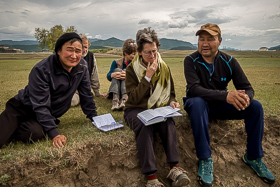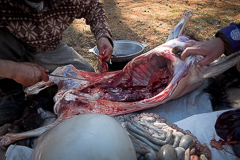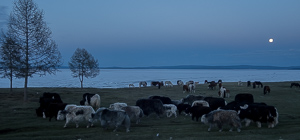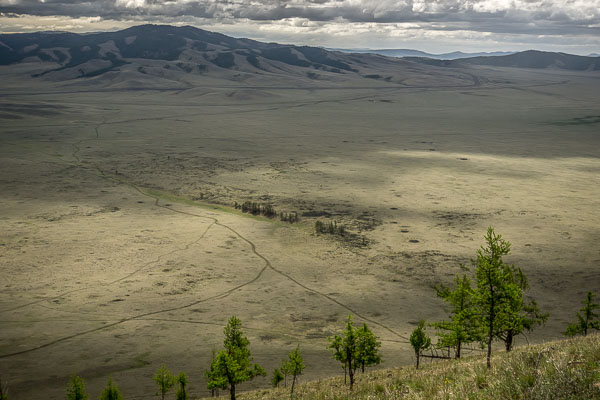Finding The Nature

Looking for a Detour Over the Selenge River
In June, people who heard of our travels to Khovsgul excitedly remarked that we would be in the nature there, or that we would be able to see the nature. Because this phrasing is used even by Mongolians who otherwise use articles the way native English speakers do, I couldn't help wondering if this use had something to do with how our two cultures understand the concept of nature. I wondered if this was simply a matter of grammar, or possibly linguistics, or if it was something that was even more basic.
For Americans, tied as we are to property, much of it urban or at least agricultural, nature is a word that we use to describe a state of being where earth's biological and geological processes are left undisturbed by man. While we can acknowledge that many natural processes thrive in the cracks of sidewalks and that small pieces of nature can exist at the edges of plowed fields, we also have a larger than life cultural memory—real or imagined—of land without limits unmarred by human habitation. The biggest, most important examples of what we define as nature are necessarily in areas of wilderness that we have had a rough time getting to. This difficult access initially prevented these places from being disrupted by logging or mining or development. But new machines and technology have provided easier ways to enter this land, allowing human activity to whittle away at it. Nature, as we defined it, needed political help from us, to protect it from, well—us.
Americans have decided to preserve certain big patches of land whose fragile ecosystems and unique beauty could easily be destroyed. By our democratically ruled governments—occasionally city and county, more often state and federal—we have shielded some of these most important samples of nature from the disruption of civilization and industry. Some of this land is developed into parks to encourage visitation and appreciation, and some of it is left undeveloped in a state of wilderness, deliberately limiting access so that only those seeking wilderness will be able to find it.

Close to the Land, Khovsgul Lake
For sure there is an appreciation for some magical places over others, as both small and large Buddhist shrines (from ovoos, piles of rocks that sometimes have flags and other offerings with them, to temples) are built in places that are especially scenic. Traditional beliefs hold that many of these places have spiritual meaning, so they are not interchangeable—not just a mountain peak, but the peak where the spirit responsible for a particular thing or kind of luck resides. I have heard it is bad luck to pee near an ovoo, but have never heard how far one needs to go to avoid bad luck. (Empirically, fifty or sixty yards has proven to be safe. So far.) From all I can see there is no problem with leaving glass and plastic bottles there, or cigarette packs that are empty, though cigarette packs that are full would make a healthier offering. Although these places are special, they are not protected from the most basic human impulse to dump waste at the first convenient opportunity. What we would consider littering sometimes seems to be encouraged by turning it into an offering. Sometimes though, it is just littering.
Walking with two of my blind guides to Mongolia, I asked them about the nature, telling them how I understood it when talking about it as an American. I told them of the difficulty I was having understanding what Mongolians meant when they talked about the nature. I asked what I would find in the nature, and how I would know when I got there.
"It is a place where it is green. There are many flowers."
"And trees?" I asked.
"Yes, trees," Angorik told me. "And there are rivers."
"So it is in the north of Mongolia?" I wondered. There are not so many places that fit this description.
"Yes, it is in the north. It would not be in the Gobi. The Gobi is desert."
"So maybe Khovsgul?"
"Yes. Maybe Khovsgul."
"And trees?" I asked.
"Yes, trees," Angorik told me. "And there are rivers."
"So it is in the north of Mongolia?" I wondered. There are not so many places that fit this description.
"Yes, it is in the north. It would not be in the Gobi. The Gobi is desert."
"So maybe Khovsgul?"
"Yes. Maybe Khovsgul."
The Mongolian word for nature is байгал, baigal, which is also the name of the world's largest fresh water lake, just northeast of Khovsgul, across the Russian border in Siberia. Lake Baikal. Green forest and lots of water, some of which comes from Mongolia.
Also when looking up the word nature in my Mongolian dictionaries, each mentioned an alternate phrase for a nature preserve which is translated as Дархан цазаат газар—sacred legal land. What a wonderful description for that reddish brown patch that can be seen near the southwest corner of the United States. Arches, Canyonlands, Capitol Reef, Bryce, Grand Canyon, Zion National Parks. Grand Staircase Escalante National Monument. All desert, but for anyone who has traveled there, sacred legal land.

Grazing Yaks and Horses, Khovsgul Lake
Two years ago we saw another part of Mongolia that is very close to being litter-free. It is not sacred legal land, but rather the land that is most important to foreign tourism. It is protected by drivers and tour operators and ger camp owners who understand that much of the reason foreigners come to Mongolia is to satisfy a desire to see such a sparsely populated landscape, with an expectation of wilderness which has, in other parts of the country, been a disappointment. For Mongolians the Gobi may not be the nature, but for those who work there, it's a place where we agree on what special land might look like.
